#accessibility modification
Explore tagged Tumblr posts
Text
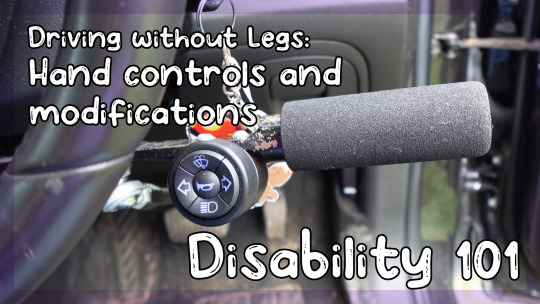
[ID: A photo of a mechanical push-pull hand control system, with "Driving without legs: Hand controls and modifications" "Disability 101" in white bubble text. /End ID]
One really common assumption I see about people who's disabilities effect their legs, such as leg amputations, spinal injuries or joint dysplasia, is that we can't drive. It's a common enough assumption that it makes its way into media portrayals of these kinds of disability all the time, though often in very subtle ways that are hard to directly point to, but noticeable once you know what to look for, or rather, what's missing. It's also an assumption I see come up more directly in the replies and reblogs to a lot of my content more often than I expected it too, and almost never as a direct question, but as statements that are part of a separate point. "My character is in a wheelchair so they need to catch the bus..." or "My leg amputee is missing the leg they need to drive so their friend/family member has to drive them to the place where the plot happens..."
but the thing is, It's a misconception! Having a disability that effects your legs or even arms in some cases (or results in you having none at all) doesn't stop you from being able to drive, at least not on it's own. It's not even a barrier to driving other kinds of vehicles, like motorcycles, aeroplanes or heavy machinery, and that's because of a type of assistive technology called vehicle modifications.
I've chosen to make this a disability 101 post, mostly because it is just kind of general disability-awareness content, even if I am focusing mostly on authors and creatives, but also because finding resources about this topic can be genuinely difficult if you don't know the names of the modifications or devices, so I've provided some resources throughout (and at the end in the sources section) that could be helpful for disabled people who are interested in getting these kinds of modifications themselves.
I do want to give a quick disclaimer before getting into this though, that I just have modifications, I'm not a mechanic or an expert on how they work, nor am I an expert of cars and other vehicles. Like anything, be sure to do your own research and fact check anything you see here, especially if the more technical stuff is relevant to you and/or your writing.
Ok, with that out of the way, let's get into it!
Cars
Lets start by talking about the vehicle modifications available for cars, trucks and other similar vehicles. For the sake of simplicity, I'm going to be referring to anything with more than 4 wheels collectively as "cars" but know this includes everything from actual cars, to trucks, to even road-trains.
Control Modifications
The most common type of control modification you'll typically see are called "hand controls" and there's dozens of types available for cars. How they do it changes, but they all work by taking the parts of a vehicle that are controlled with your feet, and make them controllable with your hands in some way.
The most common version of this, and the type I use, is called a "push-pull hand control". It works by replacing the foot pedals in (usually automatic) cars with a bar which sticks out from the side of the steering wheel that can be pushed forwards to apply the break, and pulled towards you to accelerate. This is the set-up I have in my car.
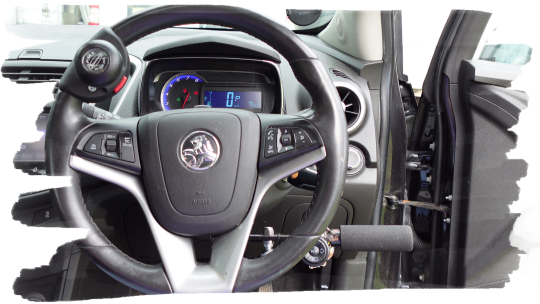
[ID: A photo of the interior of a holden car showing the steering wheel and dashboard. On the top left of the steering wheel is a round door-knob shaped grip assist, and on the bottom left is the bar of a hand control sticking out from behind the wheel. The bar has a foam grip on they end, and a circular control buttons for the blinkers, horn, headlights and windscreen wipers, though the top button is obscured by the steering wheel./End ID]
One way to set this up is done by attaching a long mechanism or pole under the steering column that physically pushes down on the pedals for you when you push or pull on the control bar. This is the type that I have, and as I understand, it's one of the cheaper ways to do it.
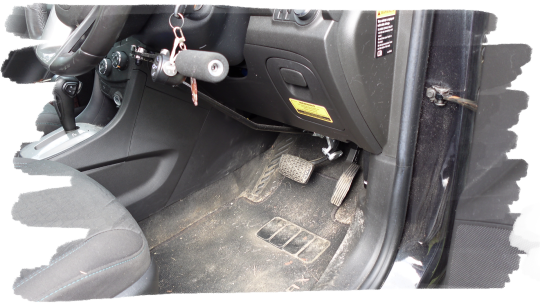
[ID: Another photo of the interior of the same car, this time showing the area where the driver's legs are supposed to go, which is covered in a lot of dust, the pedals and steering wheel. The hand control bar is fixed under the steering wheel, and a long metal rod connects the control bar to the pedals. /End ID]
(also please excuse the dirt, I live on a farm and it's been raining, so avoiding mud and dirt is impossible right now)
There are also versions of this systems that bypass the pedals entirely and connect the control bar to the car's internal systems. This is more commonly seen in electric vehicles or in cars that are being used by people with little to no control of their legs who might be at risk of pressing the pedals accidently - in which case, the pedals are also modified so they can be either folded up or shut off when the hand controls are in use, and then folded back down or turned back on when someone without a leg disability wants to drive.
There is also portable hand controls, which are very similar to permanent push-pull systems, but can be attached to almost any automatic car and removed as needed. Most I've seen have clamps that attach to the pedals, two adjustable poles, connected by a bar at the top, similar to push-pulls that essentially act as levers to press the pedals, and many are connected to the steering wheel via a Velcro strap. these are by far the cheapest and overall most flexible option, but they also happen to be mostly illegal where I live, so I've never actually seen them used in person. Technically, they can be used under very specific conditions here, but I've never met anyone who had them legally. Most people I know who tried to get approved were rejected. For everyone who doesn't live in or isn't writing a story set in NSW Australia though, Diamond Garrette has a demonstration of how they work on her YouTube channel, which I suggest checking out if you want to know more about them!
This isn't the only way the controls can be set up for the acceleration and breaking though. Other common variations include an over-ring control, trigger controls or joystick controls. In trigger hand controls, you still have a bar that extends out from the steering wheel that you push forward to break, but the accelerator is controlled using a trigger-like button underneath, similar to the accelerator on a motorbike. Joystick controls allow a driver to control steering and acceleration through a joystick (including sometimes the joystick built into the driver's power chair), and are usually a small part of larger modification systems. Over-ring hand controls, also called push-rings, are a type of control where the accelerator is tied to a ring that sits either over the top of the steering wheel, or just behind it, and you either use your thumbs to press down on it while you drive, or your fingers to pull it towards you if it's placed behind. The brake can either be another bar you push away from yourself like the others, or grip that sits beside the wheel that can either be pushed forward or squeezed in towards the wheel. If you'd like a demonstration for how over-rings work, Des Gosling Mobility has a demonstration on their youtube page! Trigger, joystick and over-ring controls are all often used by people who's disabilities effect their arms and legs, and who might have more difficulty with the heavier push-pull bar.
Because one of your hands will usually be occupied with most of these methods though (with the only exception being the over-ring and portable controls), many hand controls also have a second set of blinkers (indicators) controlled by buttons or a small flickable switch on either the hand control itself or a different location like the head-rest for easier access. While not as common, many also include extra buttons for the horn, windscreen wipers and headlights. On mine, I can control all of these "extras" through a small control pad attached to the bar, though only the blinker buttons and horn are actually connected (all the others cost extra).
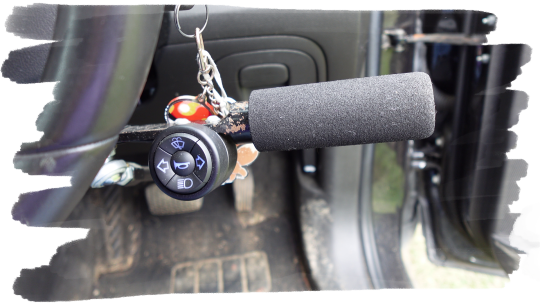
[ID: A close-up of my hand control, described earlier, to show the buttons. /End ID]
Another thing you'll often see on cars with hand-controls is either a spinner knob or some other style of grip assist on the steering wheel itself. Spinner knobs - which you can see in the first photo on this post, usually look like a door-knob attached to the top left or right side of the wheel (depending on what side of the road you drive on) that allow you to turn easier with your remaining hand, but other options include tri-rod spinners (which are mostly the same, but with three rods the user can place their hand and wrist on if they have problems with their grip) and joystick controls, which I described earlier.
I mentioned before that most of these hand-controls are mainly used in automatic cars, and that's because manual transmissions add some extra complications that, honestly, most people I know just prefer to avoid. That's not to say hand controls are only for automatic cars though, they just aren't as popular due to the extra hassle it brings. One option I am aware of is called the "duck clutch" which is a small leaver installed on the back of the gear-stick that lets you control the clutch pedal. This video from Problem Management Engineering shows how it works, though the person in their video still uses their foot for the accelerator instead of a hand controlled accelerator/break.
There are many other types of control modifications outside of these, including alternate-side foot pedals for drivers who don't have (or can't use) the leg they'd need to reach the accelerator, pedal extensions for people with dwarfism, or chin controls for people with no use of their (or no) arms. It's always a good idea to check and see if there are options available for people with you/your character's disability before making the assumption that they can't drive at all. Obviously, not every disability can be accommodated behind the wheel. For example, some autistic people struggle with the sensory processing and fast decision making needed for driving, and no amount of modification can help with that. Conditions like blindness and dementia are also pretty sure-fire disqualifiers once they reach a certain point (as both these disabilities exist on spectrums), but it's always worth checking if you've never been told for sure, especially if you are not disabled yourself.
Modifications for access
Another common kind of modification you see in cars for disabled people help them get in and out, as well as occasionally where and how they sit.
larger vehicles like vans have the most options available. My previous work vehicle (owned by a disability organisation with mostly disabled employees) for example had a large sliding door on the side that you could open to reveal a small lift. When not in use, it would fold up and sit against the door and when we needed to get in or out, you'd open the sliding door and put the lift in the "open" position, and it would lift you up to be level with the van floor so you could just roll in, or lower you down to the ground to let you out. It was a converted tradie van (a big white van usually used by electricians and other tradesmen to carry large amounts of tools and equipment) that had the back seats and a lot of the interior torn out, so you could take your chair all the way up to the driver or passenger seats and just transfer in, and I've seen similar set-ups with the lift coming out of the back as well. The major downside of these kinds of modifications, is that they require a lot of space, both in and outside of the vehicle. I dreaded taking the work van anywhere other than our planned destinations because finding parking spaces large enough for the lift to fully extend (about a metre, if I remember right) was a nightmare - though many places now have parking spots next to the accessible spaces that are kept empty specifically to help with that (if you've ever seen a parking space with stripes painted over it, that's what they're for).
Some vans can also have small fold-out ramps instead of lifts, which are a lot cheaper and don't require a power supply, but these tend to only be good if your van is low enough to the ground to keep the ramp small, otherwise getting in and out becomes a challenge. This is the approach I see used the most in wheelchair accessible taxis too.
As for the seating in vans, some people are able to get the driver's seat modified to spin around, making getting in and out of the driver's seat easier. I've also seen this in some cars and trucks, where the seat can rotate outwards to make transferring easier, or in some trucks that are higher off the ground, the seat can come out and be lowered, and then lift the driver back into the truck. While less common, I have also seen a few vans that allow wheelchair users to push directly up to the steering wheel and drive from their chair once it's secured, such as Problem Management Engineering Spacedrive system (The video linked here also contains a demonstration of a joystick control modification).
Some smaller cars and trucks can also have chair lifts installed that store mobility aids like wheelchairs either on the top of the car or, if it's a ute (a truck with a bed on the back) in the open bed.
Getting in and out without modification
Not everyone has these kinds of modification though. In fact, most manual wheelchair users I know don't have any seating or access modifications at all. For people with mobility aids like manual wheelchairs, getting in and out can be done without modifying the car in a few ways:
If someone is able to walk a little bit, they may put their wheelchair (or other mobility aid like a walker) in the boot (trunk) of their car, or on the back seat if they don't have the boot space. If their wheelchair folds, this makes it easier, but even non-folding, rigid-frame wheelchairs can fit in most car boots by taking off the wheels. If, like me, you have a car with a tiny boot where that's really not an option, many people will slide their wheelchairs onto the back seat of the car instead. Usually, this is done by putting the footplate of the chair where a person's legs would sit, and sitting the frame on the seat with the backrest up against the car seat backrest. It kind of looks like a weird booster seat once it's in. After that, wheels sit on-top of the seat. This even works with tiny cars! If a human can fit, most wheelchairs can too.
But what if they can't walk at all? well, that's a bit trickier, but its still doable for a lot of people. If we're travelling with someone, we just get them to do the steps I mentioned before, but if we are on our own, most wheelchair users I know (and myself) will get into the driver's seat, take the wheels off our wheelchairs, put both the driver-side and passenger-side backrest as low as it will go so they're both basically laying down, then pull the frame over ourselves and place it on the passenger seat in the same position as I described before. frame on the seat, footplate in the leg area and backrest up against the back of the car seat backrest once it's sat back upright - or, if you're cars a bit of a tighter fit like mine is, just put the frame and footrest on the passenger seat and leave the car backrest laying down. Then we put the wheels on top (if they fit, they usually don't) or on the back-seat. I'm a bit out of practice, since I usually have someone with me when I use the car, but this is a sped-up video showing my whole process:
[Video Description: A fast-forwarded video of Cy, a fat, white double leg amputee wearing a light purple shirt and blue jeans that cover their stumps as they get into their car, a small, black holden SUV. They start by putting their phone in the car door storage, transferring into the driver's seat and laying the seat all the way back. They then turn their wheelchair away from them and lift it so it is balancing on it's front footplate while they remove the wheels and put them to the side. With a bit of manoeuvring, they pull their wheelchair frame up, over their body, but it gets stuck, requiring them to fold down the handle bars so it will fit. They try again, but their chair gets stuck on something inside the car, out of view. Cy lowers the passenger seat to a laying down position and then continues to pull the wheelchair frame in, placing it on the seat. Lastly, they put the wheels on the back seat behind them. The video then fade-cuts to show them getting back out again, which is mostly the same process but in reverse, starting with the chair frame. They lift it over themself, then lean the chair forward so it is resting on it's footplate again, but the backrest is leaning up against the doors. They pull out one wheel from the backseat and re-attach it to the frame, then rotate the chair around and retrie the other wheel to put it back on the other side. Once both wheels are on and the chair is re-assembled, Cy then lifts their seat back up and transfers back into their wheelchair, and gives the camera a thumbs-up. /End Video Description].
Obviously though, this won't be an option for everyone. Not everyone has the strength or flexibility needed to get their wheelchairs in and over their bodies. I personally struggle with getting in and out of the car by myself because I have short arms and a big belly which gets in the way of getting my chair over the top of me to put it on the passenger seat. For people with joint dysplasia, doing this might risk something dislocating. Some power-chairs can weigh hundreds of kilograms, and no one, even able bodied, is lifting that on their own. and some wheelchairs are just physically too large to fit in a normal car, and that's when these access modifications can come into play.
Less-than-legal modifications
Sorry for yet another disclaimer, but just a reminder that this post is mostly for writing advice, which sometimes includes writing for characters who can't or don't care about doing everything correctly and by the book. It is not a guide on how to do this or encouragement to try. Do not, under any circumstances, try anything in this at home!
Sometimes, for reasons we'll talk about in a minute, “proper modifications” might not always be an option. Maybe you're writing someone who just doesn't care about the law that much, maybe they need to use an unmodified car in an emergency. Maybe its a zombie apocalypse and you can't be picky. Maybe your character just lives somewhere where the law isn't as strict. In those cases, know that disabled people have been Macgyver-ing and DIYing their own solutions for as long as cars have been a thing, regardless of what the laws have to say about it. Being in a rural area with a lot of space to drive off of public roads, I've also personally seen quite a few... creative solutions.
One especially common method to get around a lack of hand controls in cars for someone without the use of their legs, is a walking stick. Just a cheap one you can get from the shops, to help reach the pedals. I have a family friend who used to drive his old farm truck this way (again, never on public roads) and I may or may not have tried it as a teenager. It's definitely not a safe or convenient way to do it, but it's... a way, I suppose? I've also seen a few home-made spinner knobs and chair lifts to help people get in and out of trucks easier, known a few leg amputees and little people who have extended their own pedals in old farm cars so they can reach without things like prosthetics or orthotics.
humans are shockingly creative sometimes. But once again, please, do not try these at home.
Other things to be aware of
I mentioned before that disability alone doesn't always stop people from driving, but there are other things to consider for disabled drivers that you should be aware of if you're writing us (or if you're a disabled person wanting to get modifications yourself) either because they can create extra barriers, or they're just important to know.
Initially, I tried to make this section as generally applicable to people in different countries and with different disabilities as I could, but outside of the "cost" section, I don't really think that's possible unless I wanted to spend weeks researching and trying to get answers out of insurance companies and governments and this post is already really long. So instead, I think the best approach I can make on a limited timeframe is to talk about the barriers I've faced, or that people I know have faced, to kind of give you a general idea of what to look for in your own research. What barriers you or your characters face will change massively depending on your location and disability, but hopefully this will give you a stepping-off point.
Cost
So the first major barrier that a lot of disabled drivers face outside of their actual disabilities, is the cost of these modifications.
The hand controls in my personal car that I've been describing throughout the article are considered basic, and when I had to get them replaced in 2024 due to an accident, I was quoted $8,925 AUD (which is a little over $5,700 USD), just for the mechanical push-pull mechanism, blinkers and horn button, and this is pretty average in terms of price for this kind of system. I have seen them go for cheaper, for example, my first set of hand controls were second hand and it still cost around $2,500 AUD, but this was several years ago now. I think around 2016. prices for everything related to disability in Australia have skyrocketed since then.
I also happened to be working in the office the day the quote came in for the modification to my old workplace's vehicle when we first got it, (the one with the side access lift, which also had a push-pull hand control but no additional blinker/horn buttons and rotating seats) and we were told it would cost over $50,000 AUD to do all the modifications. I'm pretty confident this was also a discounted rate too, since our company had several modified vehicles and we always went to the same place for installation. Once again, this was a good number of years ago now, probably around 2018 at the latest.
Like a lot of disability aids, depending on where you live, either government-run healthcare programs, public insurance or private (usually health or car) insurance can sometimes either subsidise or cover the cost of modifications outright. However, this isn't always an option for everyone and a lot of people end up having to pay for their modifications (and all the other extra legal hoops they have to pay for, that I'll talk about soon) out-of-pocket.
In Australia, the NDIS (A disability-specific public insurance system) is generally considered to be responsible for covering vehicle modifications in the public sector, and on paper at least, they do. But like with most insurance companies, there's a million different conditions and "gotcha's" that let them get out of paying for them. My first set of hand controls were funded by them, but not without a substantial amount of arguing and a small army of both medical and mechanical experts to vouch for both me needing the modifications for my disability, and my car actually surviving long enough for it to be worthwhile paying for them. You see, at that point in time, if your car was less than 3 years old or had less than a certain number of kilometres on the odometer (I have no idea what it was, something ridiculously low), you could get your hand controls covered, mostly no problem. Statistically though, most people with disabilities severe enough to even qualify for these modifications, didn't have the money for a car that new due to systemic barriers. There was a bit of leeway though, as long as your car was less than 10 years old, you could sometimes get them covered regardless, so long as you could prove your car wasn't falling apart on the road already. Unfortunately, my car was from 2004. So... a little bit outside that window. Honestly, I don't know how we got it approved. Today, those rules are a bit different, they've extended the "usually fine" margin to 5 years OR if your car is still under a manufacturer's warranty, but the 10 year cut-off is much stricter than it used to be (because as we all know, after 10 years your car just starts to disintegrate, obviously).
There are also a bunch of other seemingly random things that can disqualify you from getting vehicle modifications covered, including "not being good value for money" or there being other services available (when I applied they originally tried to argue this with me, and suggested public transport was an option). Honestly, whether or not you get approved for them or not just seems to come down to who was working in the office at the NDIA that day and if they'd had their morning coffee when they saw your request. If you want to know more, this is the publicly-available outline the NDIS has. If you live in Australia and you're thinking of getting vehicle modifications yourself, it's worth a read, but be mindful it's never as simple in reality as it is in these kinds of outlines.
In Australia, private health insurance will cover it sometimes, and I know a few people who got theirs that way, though I don't know what the process is like. I do know private car insurance will also replace existing modifications if you're in an accident that destroyed your old ones, which is how I got my second set of modifications. Also after a lot of arguing. You see, in Australia, our disability anti-discrimination law, the DDA, does protect disability-related car modifications as essentials that can't be charged extra for, but that doesn't mean insurance companies won't try to get out of covering them if they can. Many will claim they don't have to cover the modifications unless you paid for "extras" to be insured too, and bet on customers not knowing that's against the law. Unfortunately, the DDA is a massive law and while most people know it exists, they don't know exactly what it covers and this lie ends up working. Even if a person does know it's illegal, if an insurance company refuses to budge once its pointed out to them, many disabled folks don't have the time, energy or money to actually hold them accountable in court, so they still get away with it, and another barrier is created, even if, legally, it's not supposed to.
From what I was able to find, in America, private insurance companies will sometimes cover the cost vehicle modifications (assuming you can even afford insurance to begin with) but even if you get them, another barrier arises in the form of insurance premiums. unlike the DDA, their ADA doesn't always protect the modifications as essentials. Because of that, it's not uncommon to have to pay more on car insurance if you do have them and want them covered, which presents a different kind of cost barrier and makes driving with them legally riskier.
Legal restrictions and getting "approved" for use
I mentioned this in passing before, but in order to get modifications for your vehicle, at least in Australia, you actually have to get "approved" by your state government to be able to use them at all. Also, in NSW, for control modifications like hand controls, once you're approved to use them, that's all you're allowed to use. This means, if you and your friend both own a car with different kinds of hand controls, you're not allowed to use the other person's car. This was actually the case for me and my previous roommate, she had an over-ring, while I had the push-pull mechanism. Legally, we couldn't drive each other's cars. Despite both having hand controls and being physically able to drive each other's cars, we weren't legally allowed to.
This is because in most places around the world, the modification of cars in general and specifically the use of alternate controls systems like hand controls are very heavily restricted for a variety of safety reasons (some of which are reasonable, and others... eh... not so much) - Even some US states forbid things like spinner knobs from being used without state government approval. Australia is... a little extra in this regard, to put it mildly, and their restrictions can be serious barriers all on their own.
Usually, to get approved to use modifications here, you have to go out with an Occupational therapist to test which type of modifications work for you. For control modifications specifically, once a best fit is found, this will be added as a condition to your licence, meaning you can now only drive with that style of control. This isn't too bad if you get your modifications covered by the NDIS or insurance, since they'll usually cover the cost of the OT as part of this, but if you're one of the unlucky people that can't get covered, you also have to pay for the OT, which can be thousands of dollars on top of the other costs.
Access to installation and maintenance
Another major barrier for a lot of disabled people who need these kinds of modifications is physical access to someone who can actually put them in and maintain them.
You see, not just any mechanic can install disability modifications, especially control modifications. You have to go to a specific type of engineer. The only exception to this rule, as far as I'm aware, is the portable hand control, which is a big part of the reason why they're banned in my state, as they can't be assumed to be safe.
Unfortunately, this is a pretty niche area of speciality, so there aren't a lot of options to get the installations done. There are only 8 in all of NSW (which has an area bigger than 3 times the entire UK), according to Australia's National Equipment Database, and the vast majority of them are in the Greater Sydney Region. This means, if you don't live near Sydney, you're out of luck for the most part, unless you can spare a few days to make the trip (since the installation can also take some time). Some companies do offer to come and get the vehicle for you, but not all, and even those that do, may not be able to come get it if you're 8+ hours away.
And that's just the installation. Thankfully, normal car maintenance still can be done by a general mechanic, even with modifications installed, but if anything happens to the modifications themselves, you normally have to go back to the person who installed them for repairs. Personally, I now live around 4 hours out of Sydney, and around Christmas, the wiring in my hand controls failed. It was a simple repair, but my partner and I had to go all the way back to Sydney for it, and we had a lot going on at the time, so we had no choice but to leave it for over a month. Meaning there was a whole month where I just couldn't drive.
Uneducated Law Enforcement
Ok, so this one is kind of a... luck of the draw situation and it's not a common barrier in my personal experience, but I also recognise that, as a white person who can still pass as cis if needed, my experience here won't be universal. Disabled people with intersecting identities such as POC and visibly queer folks, may have a substantially harder time with this.
Unfortunately, because disability modifications are not super common in the general public, it's not uncommon for police to have never seen them before. And when police don't know about something, that can become your problem very quickly. Most of the time, there's no issue, but I have been accused on two separate occasions of having "illegal racing modifications" in my car, because the police didn't know what a hand control was and jumped to that assumption (I'm not even sure what they would have been confusing them for, I've seen racing mods and they don't look anything like hand controls). I was also once told I'd have to get my car towed when on my way to get it checked by a mechanic for registration, because the officer didn't believe me that a regular mechanic could do it due to my hand controls, so obviously I must be lying and trying to drive my unregistered car around town (I don't know what the law is in other places, but here you are allowed to drive an unregistered vehicle to the mechanics if they know you’re coming). Both situations were pretty minor and were resolved quickly, but they could have easily been a lot worse if the officers decided not to believe me, or in the case of the second situation, they didn’t believe the mechanic who had to be called to convince the officer I was telling the truth.
Other Kinds of Vehicles and Modifications
Cars aren't the only vehicle you can modify to drive with a disability, they're just the most common! Honestly, each other vehicle was originally going to be it's own segment, but this post is already incredibly long, so here's just a quick overview of the modifications I know about for other vehicles!
Motorbikes and trikes often don't need much in the way of control modification for most riders, but many bikes can be modified to be easier to balance on or hold a wheelchair, either on the back or side, and trikes can be made to allow the rider to stay and ride from their wheelchair directly.
The laws for this are different everywhere, but in Australia and the UK, light aircraft can also be modified to be accessible to people with some physical disabilities, including wheelchair users with hand controls. Wheelies With Wings is a Melbourne based organisation the specialises in helping wheelchair users learn to fly . For those in the UK, Freedom of the Air offer similar services. Though as you might expect, there are some pretty substantial cost barriers involved for this.
I also know a few people who have also (legally) modified their farm equipment, like tractors or even heavy machinery, like bulldozers.
Pretty much anything can be modified. More often than not, if something can't be, it's usually more due to legal problems than it being physically impossible.
Conclusion
There's so many kinds of vehicle modifications out there, for all different kinds of vehicles, this is really just a general overview, so be sure to research what would be applicable to you or your characters
Sources
Over Ring Accelerator Demonstration
Driving With A Disability - Portable Hand Controls
Duck Hand-Operated Clutch System
NDIS vehicle mods PDF
Vehicle Modification Agents Vehicle Modification Agents Database
Wheelies With Wings Facebook page Link
Freedom of the Air Link
#writing disability with cy cyborg#disability 101#long post#writing disability#disability representation#hand controls#vehicle modifications#accessibility#accessibility modification#driving#disabled#disability
192 notes
·
View notes
Text
I'm gonna bully Lif again
I'll admit, some of these answers don't cover all the bases, but. What are we thinking, here. What is The Truth behind The Twink Death? 🤨🎤
I will also be accepting write-in responses as usual 🫡
#fire emblem#feh#fe lif#fe alfonse#one answer i refuse to put on here just bc of how badly i think it would squeue results:#has exclusive access to bruno's workout routine#BUT I FEEL LIKE. IF I PUT THAT AS AN OPTION. EVERYONE WOULD PICK IT. I WOULD PICK IT IN A HEARTBEAT#some of my own notes: changing up the body modification option to be more vague#BUT. some thoughts were 'via surgery/magic' and specifying he sought it out himself#i just simplified it to look better on the poll. but the IDEA here. ESPP in the same vein as the insoles#i cannot remember where. but i feel like it's canon that alfonse has a degree of body dysmorphia?#or at very least has some insecurity about it. not being as tall as gustav/bruno (sir. you are allegedly 5'11.)#and not being as muscular as them either. i swear to god i'm not just making this up. it has to exist in SOME obscure line somewhere#or i just hallucinated that. but then again i found out one of my long-standing hcs actually had a basis IN canon#i just. forgor. so. anything is possible 💪💪💪 (this one was about alfonse/sharena/bruno being childhood friends)#badly wanted to make another undead joke but now i'm paranoid that i'm spreading misinfo#like i think The Lore is that lif and theasir were sole survivors. technically not rezzed. but like.... gah#i do gotta finish my book 3 replay. i promise i will. i'm SO close (has to do book 2 quotes first)#still the embalming accident option no elaboration is just too funny to me. cannot pass it up#ALSO. ALSO. the veggies/milk option. is mostly a joke but goes back to my hcs about#alfonse being scrawny as a kid up until he joins the order. actually starts to fill out more#when he feels inexplicably more secure. also sharena helping any way she can.#LIKE. ALL OF THESE ARE SILLY. but a lot of them have internal lore reasons. varying degrees of actual canonness#i also want each option to be compelling in some way. like what does this say about him#or what happened to him. just. in general.#THERE'S. KINDA NO GREATER PURPOSE TO THIS BTW. kinda.#it's just that whenever i think anything even vaguely related to book 3 i get the UNFATHOMABLY PROFOUND URGE#to stick a kick me note on lif's back and wait.#it's either that or just blackout horny. no in between. also the grief. i need to kill him again.
16 notes
·
View notes
Text
like technically echolocation no jutsu locates life, as it identifies where chakra is and chakra being pretty much life.
so it's like. no wonder Iruka is a life loving guy. if he was in the middle of the destruction, making chakra pings, searching for his parents, and finding the world around him to be so much emptier than it used to be
#bogs' muttering#what ab rock lee? im pretending it's more like dorohedoro magic biology rules in that you need body modification to access it#he's got chakra but his body just doesn't have the functionality to do anything with it
8 notes
·
View notes
Text




Cable management is his passion, titties his weakness...
He would have probably done it without anything in return if it weren't in Crime Central Station where Layan lives
#my ocs#ocs#oc: warnerkva#oc: layan#spinax is their main alien deity/spirit#it comes from smt dumb if you recognize what it is you get a free drawing from me im serious gdffgqdfhgqfd#redoing the cable management in every city is NOT on his job tasks but he Will do it out of passion#and bc seeing bad cabling in a place where he has the access to do modifications greatly upsets him he has to fix it#he probably gets nicknamed fangs a lot#weinks have pointy canines but his are particularly visible like a vampire#he's not the only one tho#and it's 100 % an aesthetic choice#the weink chieftains
4 notes
·
View notes
Text
TUMBLR WHAT THE FUCK IS THIS.

COMMUNITIES TAB IN THE MIDDLE OF THE LOWER BAR???!!! 😡😡😡😡😡😡
#tumblr updates#tumblr#IM SO FUCKING TIRED OF APPS CHANGING SHIT AROUND THAT WAS GOOD#maybe my emotions are elevated bc outside stressors and I’m high or smth#but FISHEKXHIWJXIWJDIWJDJEJDNEJ CHRIST#it’s filling me with boiling rage. Istfg it’s like ptsd or shit (not really ik)#just like#Instagram turning into a fucking shithole when it adding the shopping tab and moved the ‘likes’ button#like URGHHHHHHHH#enshittification#tumblr is its own trap because what other social media never ever shows follower count(or other public stats#that fuck u over mentally#etc etc.#idk it’s just like. am I gonna have to create a faux-tumblr app that would be so hard to market in this era of lonely spin-off apps#where can I engage in fandoms this way.#there’s so much fandom history and internet history in general on tumblr. it’s a shame to turn this app into the same garbage that people#barely stand on other apps. that I can’t fucking stand which is why I LEFT those other apps#mypost#ik there’s that web tumblr extension that lets u alter hella tumblr stuff#but I hold so much anger towards the idea that an app could force me to access it through hella 3rd-party modifications
5 notes
·
View notes
Note
hiiiiiiiiiiii!! Did Joseph choose the design of his wings? i guess they were linked to genes and mutation so maybe he couldnt choose...
regardless, do Joseph's parents like . babyproof the claws on his wings? Those bad boys are POINTY and not really suitable for 10 year-olds methinks ... i dont want my boyo to get hurtie sniffles
yess he did! the way their society has developed it, aesthetic changes can be performed like how we do normal surgery, just much more advanced, or genetically, but that typically has certain limitations (easier to change certain aspects of already existing traits than create entirely new ones). joseph's aesthetic alterations were surgical, so his body was manually remade where necessary to enable the construction of wings that also function (aka he can move them and they're an extension of his body with nerves and shit rather than just something taped on.) we imagine he'd probably need some sort of additional help when it comes to growth though because his body can't do that by itself. aka expensive both initially and for upkeep oughh 🤕 meanwhile five has an aesthetic alteration in his hair that's more genetic, so he wasn't born with hair like that or had anyone in his family which would allow hair like that, but since his actual genes have been altered his hair now naturally grows white/black and it can be passed on to any kids he might have. if joseph did gain wings through more natural means so that any genetic traits he had prior would determine color, he could also choose to have those traits altered so that his wings would look different.
he specifically chose his wings to appear the way they do because of the connection to a highly respected group revolving around justice that considers themselves modern day knights, whose members all take care to resemble green dragons. it's both formal and informal i.e. there's an actual organization of proper members who are fully connected to each other, and people who aren't a part of the actual org but subscribe to their beliefs and align with them both in appearance and behavior. other aesthetic changes come with certain associations by result of people being people, so while it's entirely possible and fine to just want the green dragon vibe while not caring for the org, people will still assume you're associated. stuff like that would probably manifest in a lot of different ways, like people assuming you're a fan of a celebrity because you have a similar added trait that a celebrity has, or thinking you're annoying because you have pink hair and everyone who gets pink hair is annoying duhh, etc etc. but in this case it's an association joseph wants, even though some people might see it as a bad thing.
and they do not 😇 he'd probably go crazy if they tried babyproofing it and would just remove it. tbh he'd probably accidentally hurt other people more than he would hurt himself... kind of just one of those things he has to be aware of so he probably knows how to watch where his claws are atp.
#joseph performs the surgical equivalent of buying a fursuit when you're 13 even though you're gonna grow and you'll need a new one#if any SCIENCE NERDS wanna be all 'ermm actually the way you explain genes and surgery is wrong because-' shhh...#besides it's also important to note that a lot of advancements are magic assisted and so they can get away with a lot more#while it'd be expensive we like to think it wouldn't be as expensive as such a surgery would be in the real world because#of how common it is and the fact that it's inherently easier for them. surgery and other bodily manipulations are super focused on#hence making them much safer easier and by result much more accessible#the main premise is kind of just extending those modifications to the mind as fucked as that sounds#by reverse engineering mind alteration based magic and making it long term#hence influencing people's political stances to extreme points#grins#ioi#ioi joseph#asks
5 notes
·
View notes
Text
[ID: Two small white creatures with tall ears sit side by side on a colorful fish. The fish has a rainbow gradient and colorful starbursts on it’s fins. Surrounding them are jellyfish and other fish, as well as stars and spirals in bright colors in a dark blue background. End ID]

✶ the ocean at night ✶
#this is so pretty!#op please add the ID to the original post with any modifications you want#so that the post is more accessible!#described by me#art
13K notes
·
View notes
Text
existence is exhausting and expensive, especially if you're ill
i'm just so tired generally, but also more specifically of how goddamn expensive it is to be sick. have to buy special lotion for my psoriasis, have to buy all these extra vitamins and supplements for my wonky stomach and shit genetics, have to make sure i have bandages and alcohol and a sharps container on hand to do my weekly injections, have to buy medical grade fucking shaving cream because every commercial brand on the market irritates the hell outta my skin and many of them make my immune system go postal as well. i have to constantly budget for unexpected courses of antibiotics for random infections i get because i'm immunocompromised, and for the accompanying medical bills, and the random co-pays for specialists. still working for hourly pay, losing so many of those hours because i'm too sick to work, having to go back to the dr because i push myself too hard trying to have a life and work at the same time, losing more hours at work, losing more money, back to square one with cents in my bank account and a ton of problems i still can't fix. it is inescapable. constant logistical concerns, constantly weighing the pros and cons of every single choice according to need or finance, constantly having to make room for new issues i can't control. i'm so tired. i'm so tired.
#disabled should be paid a comfortable wage regardless of productivity#we should be compensated for all the special shit we gotta buy just to function that abled people don't#we should get fucking tax write-offs for making accessibility modifications and medical equipment stipends and multiple#mobility aids and prostheses at the same time and we should never have to pay for specialist treatments#and we should never have to make the choice between our medicine and a meal#i'm so tired
0 notes
Text
7 Shocking Home Mods for Aging in Place You NEED to Know!
7 Shocking Home Mods for Aging in Place You NEED to Know! 7 Shocking Home Mods for Aging in Place You NEED to Know! Welcome, friends! Let’s talk about something that’s probably crossed your mind, especially if you have aging parents, or maybe you’re even starting to think about your own golden years. It’s the idea of “aging in place.” Sounds lovely, doesn’t it? Staying in your own beloved…
0 notes
Text
Wheelchair Accessible Home Design: Creating a Safe, Stylish, and Functional Space for All
A well-thought-out wheelchair accessible home design not only ensures safety and independence but also enhances the quality of life for seniors, veterans, or individuals with mobility impairments. #wheelchairaccessiblehome
#wheelchair accessible home#home design for mobility#accessible living spaces#universal design home#ADA home modifications#safe home for seniors
0 notes
Text
Aligning Stakeholders on Multi-Tenant Renovations Using a Commercial Estimating Service
Multi-tenant commercial renovations involve transforming office buildings, retail centers, or mixed-use spaces occupied by multiple tenants. These projects are often complex because they require coordinating diverse tenant needs, maintaining operational continuity, and managing shared spaces. In this context, a commercial estimating service plays an essential role in aligning stakeholders around budget expectations, scope, and timelines, thereby ensuring smoother project delivery and minimizing conflicts.
Understanding the Challenges of Multi-Tenant Renovations
Renovating spaces with multiple occupants presents challenges not typically encountered in single-tenant projects. Tenants may have different priorities for layout, finishes, or systems, and some areas require partial occupancy during construction. Additionally, shared infrastructure like elevators, lobbies, and parking must be maintained or carefully phased.
This complexity requires clear communication, thorough planning, and precise cost estimating to prevent budget overruns and scheduling conflicts that could disrupt tenants’ businesses.
Establishing a Common Budget Baseline
The first step to stakeholder alignment is developing a comprehensive cost baseline that reflects all anticipated renovation activities across tenants and common areas. Commercial estimating services provide detailed breakdowns by tenant space, common areas, and building-wide systems.
This baseline enables landlords, property managers, tenants, and contractors to have a shared understanding of the financial scope. It also supports negotiation of cost-sharing arrangements, tenant improvement allowances, and lease modification budgets.
Capturing Diverse Tenant Requirements
Different tenants may require varying levels of finish, technology integration, or space customization. Commercial estimators work closely with design teams and tenant representatives to capture these unique requirements and reflect them in separate cost lines.
Breaking down estimates by tenant ensures transparency and fairness, enabling stakeholders to see how their specific needs impact overall project cost.
Phasing and Scheduling Cost Implications
Multi-tenant renovations often proceed in phases to minimize disruption. For example, one floor may be renovated while others remain occupied. Commercial estimating services assess cost impacts of phased work, including extended site supervision, mobilization, and overtime labor premiums.
By clearly identifying these additional costs, estimators help stakeholders set realistic expectations about schedule duration and budget.
Managing Shared Infrastructure and Common Area Costs
Shared systems such as HVAC, fire alarms, elevators, and lobbies require coordinated renovation efforts. Commercial estimating services allocate costs appropriately between tenants and landlords, helping define responsibilities and cost-sharing agreements.
This clarity reduces disputes and supports equitable budgeting for common area improvements.
Facilitating Transparent Stakeholder Communication
Accurate and detailed cost reports are essential tools for communication. Estimators produce clear documentation that explains cost assumptions, contingencies, and alternatives.
Transparent reporting builds trust among stakeholders, enabling them to participate actively in value engineering or scope adjustments to keep the project financially viable.
Supporting Lease Negotiations and Tenant Improvement Allowances
Commercial estimating services provide data to support lease negotiations, especially regarding tenant improvement (TI) allowances. By quantifying the cost of specific tenant upgrades, landlords and tenants can negotiate fair contributions.
This helps avoid surprises later in the project and aligns lease terms with renovation realities.
Incorporating Risk Management and Contingencies
Renovations in occupied buildings carry risks such as unforeseen conditions, tenant change orders, or delays. Estimators incorporate contingencies based on project complexity and past experience, ensuring budgets include buffers for such risks.
Clear communication about these contingencies helps stakeholders appreciate the inherent uncertainties and plan accordingly.
Adapting to Changes and Tenant Requests
Multi-tenant renovations often evolve as tenant needs change or new opportunities arise. Commercial estimating services provide flexible support by updating cost estimates in real time, helping stakeholders evaluate financial impacts of changes before committing.
This adaptability promotes informed decision-making and keeps projects on track.
Ensuring Compliance with Building Codes and Accessibility
Renovations must meet current codes and accessibility requirements, which may differ across tenant spaces. Estimators factor in costs associated with code upgrades, helping stakeholders understand regulatory obligations and budget accordingly.
Early identification of these costs prevents costly rework or compliance issues later.
Improving Bid Competitiveness and Contractor Coordination
Accurate estimates support competitive bidding by providing clear scopes and budgets. This improves contractor selection and reduces risks of cost overruns.
Commercial estimating services also help coordinate between contractors and tenants to minimize disruption during construction.
Conclusion
Multi-tenant renovations require balancing diverse stakeholder interests, budgets, and schedules. A commercial estimating service is a critical partner in this process, providing detailed, transparent, and adaptable cost estimates that enable alignment and collaboration. By clarifying financial expectations, supporting lease negotiations, managing risks, and accommodating changes, these services help ensure successful multi-tenant renovation projects that satisfy tenants and property owners alike.
#commercial estimating service#multi-tenant renovation#tenant improvement allowance#phased renovation cost#shared infrastructure cost#tenant coordination#lease negotiation cost#renovation contingency#tenant space budgeting#common area renovation#HVAC upgrade cost#fire alarm upgrade estimate#elevator renovation cost#construction cost transparency#risk management estimating#change order estimating#building code compliance#accessibility upgrades#renovation scheduling#project phasing#tenant customization cost#landlord budgeting#renovation cost allocation#contractor bid support#tenant disruption minimization#lease modification budgeting#renovation project communication#multi-tenant construction#renovation project estimating#commercial renovation budgeting
0 notes
Text
5 thing Medicare does not cover (and how to get them covered
https://notegpt.io/workspace/detail/b-_Yrm2w4Ao Medicare Coverage Overview: Medicare consists of two main parts: Part A (hospital insurance) and Part B (medical insurance). Most medically necessary services like emergency room visits, doctor’s office visits, hospital stays, diagnostic testing, and many non-self-administered medications are generally covered by Medicare. Cost Sharing…
#accessibility remodeling#accessible bathrooms#accessible home#aging in place#best modifications for aging parents#boomer housing#CAPS contractor#caregiver resources#certified aging in place#cheap senior home repairs#dementia friendly homes#disability home mods#DIY home safety for elders#elder home repair#elder home repair [your city]#elderly safety#emergency home repair#fall prevention#fall proof your home#grab bar installation#home mods before winter#home safety for seniors#how to pay for home modifications#HUD home repair#low income home mods#medicaid waivers#non slip flooring#nonprofit home repair#prepare to age in place#retirement home prep
1 note
·
View note
Text
DreamBath

DreamBath by Honey Do Home Improvement is your trusted expert in bathroom remodeling, bringing 30+ years of industry experience to every project. We specialize in full bathroom transformations, custom designs, flooring, tiling, lighting, & accessibility upgrades to create beautiful, functional spaces tailored to your needs. You can have your dream shower or bath installed in as little as one day, giving you a quick, hassle-free upgrade without compromising on quality. Plus, we offer free in-house estimates to make the process simple and stress-free. Serving Sumter, Florence, Columbia, & Charleston, we deliver expert craftsmanship, transparent pricing, and a seamless remodeling experience. Contact us today to start your transformation today!
Business Hours: Mon — Fri: 8:00 am — 5:00 pm | Sat & Sun: Closed Payment Methods: Cash, Debit Card, Visa, Mastercard, Invoice Contact Name: Talbert Floyd
Contact Info: DreamBath Address: 860A W Liberty St, Sumter SC 29150 USA Phone: +1 (803) 968–9904 Mail: [email protected] Website: https://dreambathsc.com/
Find Online: Facebook: https://www.facebook.com/DreamBathSumter/ Instagram: https://www.instagram.com/dreambathsumter/
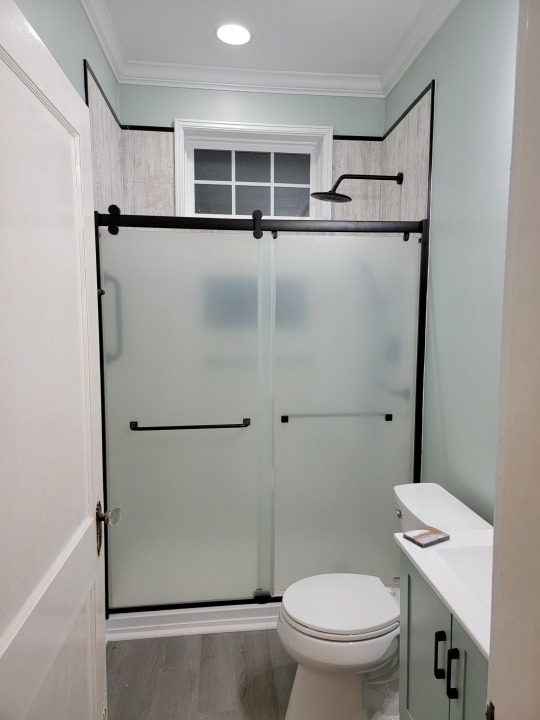
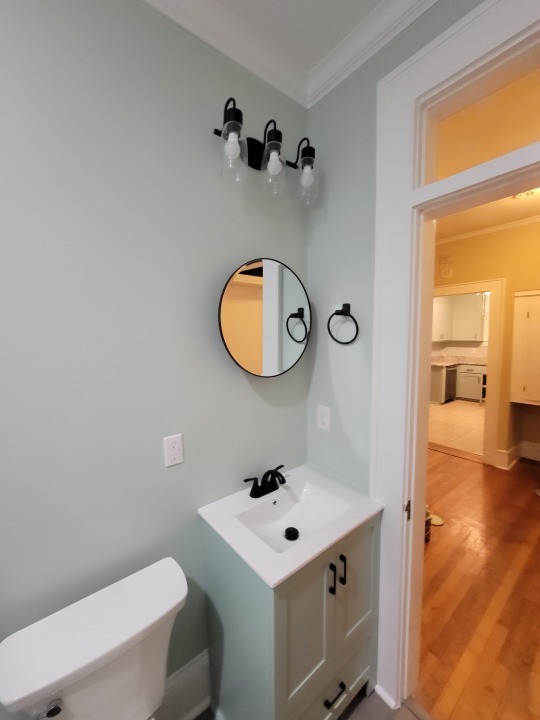
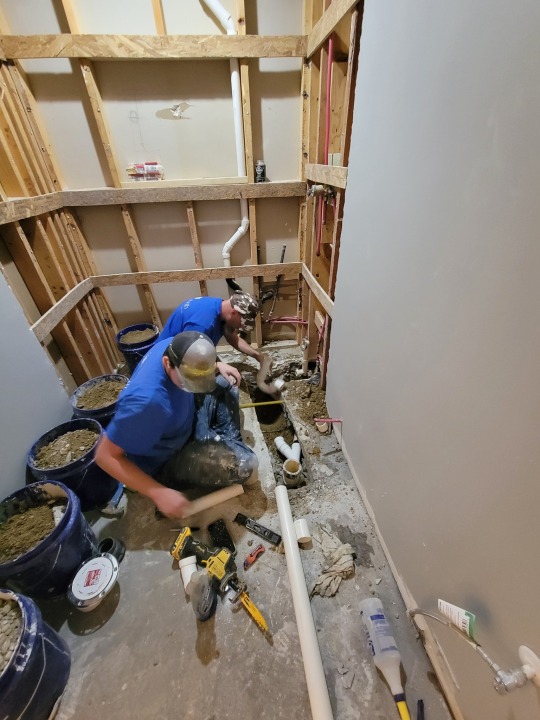
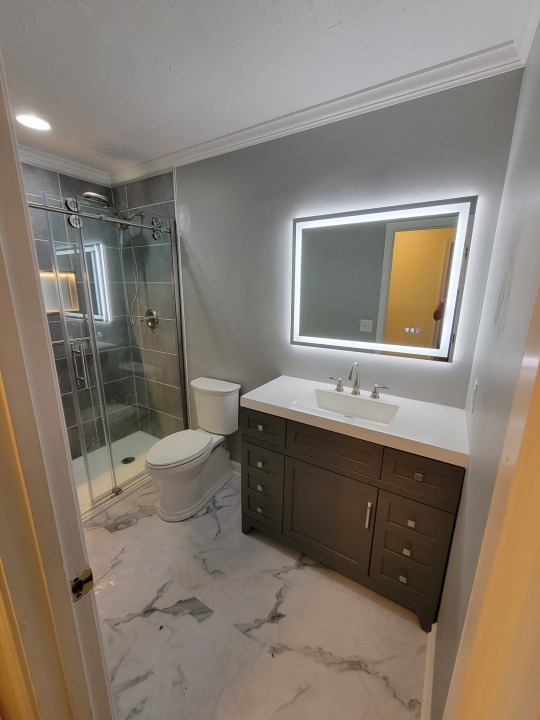
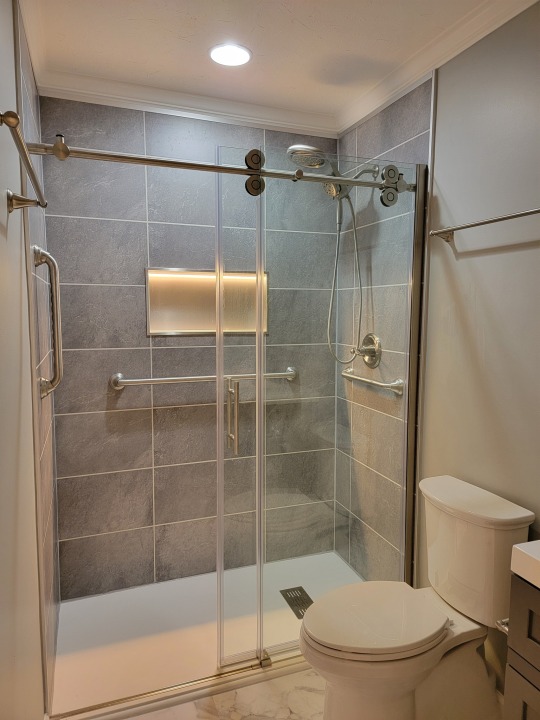
#Sumter Bathroom Renovations#Bathroom Remodeling Sumter#Sumter Tile and Flooring Services#Plumbing and Electrical Sumter#Bathroom Accessibility Modifications Sumter#Lighting Installation Sumter
1 note
·
View note
Text
Enhance Vehicle Accessibility with Mobility Scooter Lifters
Enhance your independence with portable mobility scooter lifts, designed for effortless transportation. Our lift systems for mobility scooters provide seamless loading and unloading, ensuring hassle-free travel. Discover a range of accessible vehicle modifications tailored to meet your needs, perfect for pairing with the best mobility scooters Australia has to offer. Whether you're exploring the city with mobility scooters Brisbane or seeking reliable portable mobility scooters, our solutions ensure convenience and accessibility. Looking for affordable options? Check out our selection of cheap mobility scooters and innovative lifter systems to enhance your mobility experience today. To know more, read the full blog here: https://activescooters.com.au/enhance-vehicle-accessibility-with-mobility-scooter-lifters/
#Portable mobility scooter lifts#Lift systems for mobility scooters#Accessible vehicle modifications#best mobility scooters Australia#mobility scooters Brisbane#portable mobility scooters#cheap mobility scooters
0 notes
Text
Genuine question- do italics/bold/underline work on screen readers? (if not, is there a good way to emphasize text you would suggest?)
OPEN LETTER TO FANFICTION WRITERS ON ACCESSIBILITY; PLEASE READ.
first of all, thank you for spending your time, seldom acknowledged and definitely deserving of a compensation you are not receiving, to entertain us. i’m speaking on behalf of more than just blind readers, but everyone. you’re sick as hell.
i’ve summoned you to provide some information you may not already know. i know a lot of you like fonts. especially those who cross post their work on wattpad. i admire any and all acts of aestheticism to a degree, and can understand the desire to use them. (blind folk, sorry y’all. momma’s making a point.) 𝔰𝔱𝔲𝔣𝔣 𝔩𝔦𝔨𝔢 𝔱𝔥𝔦𝔰, it’s cute. 𝐬𝐭𝐮𝐟𝐟 𝐥𝐢𝐤𝐞 𝐭𝐡𝐢𝐬 is a little cuter to me, if i had to choose. or maybe 𝓈𝑜𝓂𝑒𝓉𝒽𝒾𝓃𝑔 𝓁𝒾𝓀𝑒 𝓉𝒽𝒾𝓈?
now, sighted folk: if you’re on mobile, i implore you to participate in a little exercise for me. select this text and scroll through all the copy/paste/define/‘search the web’ options until you get to the speak portion. if you need to change a setting for your phone to do so, would you mind? i’d really appreciate it.
please make your phone read aloud part of my post, and be sure to include any bits with those super cute fonts. 𝕚’𝕝𝕝 𝕥𝕒𝕔𝕜 𝕠𝕟𝕖 𝕠𝕟 𝕥𝕙𝕖 𝕖𝕟𝕕 𝕠𝕗 𝕞𝕪 𝕡𝕝𝕖𝕒, 𝕣𝕚𝕘𝕙𝕥 𝕙𝕖𝕣𝕖. 𝕚 𝕙𝕠𝕡𝕖 𝕥𝕙𝕚𝕤 𝕚𝕤 𝕥𝕣𝕒𝕟𝕤𝕝𝕒𝕥𝕚𝕟𝕘 𝕔𝕠𝕣𝕣𝕖𝕔𝕥𝕝𝕪, 𝕚 𝕕𝕠𝕟’𝕥 𝕨𝕒𝕟𝕥 𝕥𝕙𝕖 𝕝𝕖𝕤𝕤𝕠𝕟 𝕥𝕠 𝕓𝕖 𝕤𝕢𝕦𝕒𝕟𝕕𝕖𝕣𝕖𝕕 𝕓𝕪 𝕥𝕪𝕡𝕠𝕤 𝕚 𝕔𝕒𝕟’𝕥 𝕤𝕖𝕖.
whether you participated and discovered it for yourself or you thought this was a crock of shit you’d rather not sniff, i’ll tell you! screen readers cannot dictate words using those fonts. at least, on a majority of devices. not mine, or any of my mutuals elsewhere.
you do not have to change your behavior on my behalf, but please be aware that fonts limit access to your work.
blind readers do exist, i exist, and i am bound by the same feelings of dogged longing that make other sad horny bitches read angsty, smutty, father-wounded nonsense.
thanks for making it this far. i really hope my sincerity is being conveyed, reading makes me so happy and i’m not the only person on this app who relies on accessibility settings more often than not. do with this information what you will, and have the day you deserve!
#writing#text post#accessibility#huh i did not realize that!#i guess i always assumed the fonts were all just visual modifications of the 'base' text that screen readers would read#thank you for informing me#i looked it up but im getting mixed answers#i tend to use italics for thoughts/visions/flashbacks
6K notes
·
View notes
Text
Inspired by my wild misinterpretation of @here-comes-the-moose's post about what kind of packer Echo is, Echo with a packer post-skako
He's got maybe a little more lower body damage and for whatever reason elects to use an STP device - makes his life a little easier and he's already got a bunch of new accessibility devices and prosthetics so it makes sense.
Normally it's completely a nonissue but once and a while it falls out of his pants or someone shuffles it around when he's not wearing it and the chaos... i know tbb would not be normal about it
#SO MANY DICK JOKES#also genuine concern and alarm from ppl wjo dont know#i think crosshair wld not pay attention until it fall out his pants in front of him and he's just like WHAT THE FUCK. ALARM#wrecker and hunter i think would know and wrecker jokes while hunter is like. the only one whos normal abt it#tech is like I Am Going To Improve Your Penis and echo is like please do not. please keep your paws away from my dick#hunter wld probably actually hate it as an Object Seperate From Echo bc it always sort of smells like pee to him and he Gets It#but also STOP LEAVING YOUR GODDAMN PENIS AROUND ECHO#echo who had 2 clean sterilize dry it n does Not care hes not getting a complex uti: cope#idk if its just a stp device or its also pack n play idc#tbb#truly i would Not want tech to get his hands on any accessibility/assistive device he would 'improve' it without consent#and while thats sweet in theory in practice familiarity is best and Dont Fucking Touch I Will Tell You If I Want Modifications#anyway tldr: ECHO YOUR PENIS#SOMEONE CATCH IT ECHOS DICK IS BOUNCING AWAY#*Horrified screaming as someone lobs a load of laundry [and also penis] at someone else*#*muffled yelling from across the marauder* WHO MOVED MY PACKER IM NOT SQUATTING TO PISS IN THESE WOODS#Echo can i scare regs w ur penis. no. echo can you scare regs with uour penis. NO#echo who just wants peeing to be more convenient: *ben affleck cigarette meme*
0 notes